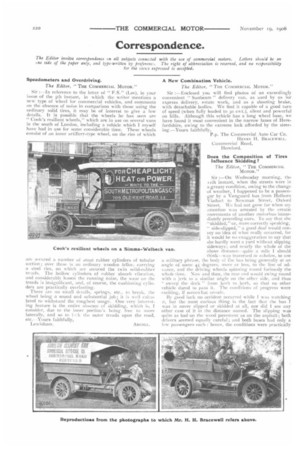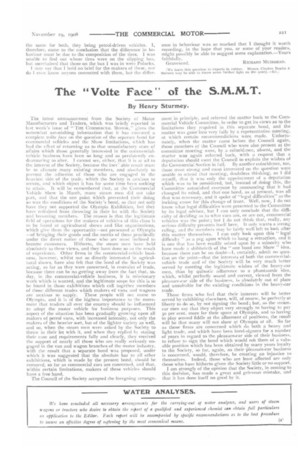Correspondence.
Page 14

Page 15

If you've noticed an error in this article please click here to report it so we can fix it.
The Editor invites correspondence on all subjects connected with the use of commercial motors. Letters rue side of the paper only, and type-written by preferenc:. The right of abbreviation is reserved, and no for the views expressed is accepted.
Speedometers and Overdriving.
The Editor, "THE COMMERCIAL MOTOR."
Sir :--In reference to the letter of " F.S." (Lee), in your issue of the 5th instant, in which the writer mentions a new type of wheel for commercial vehicles, and comments on the absence of noise in comparison with those using the ordinary solid tires, it may be of interest to give a few details. It is possible that the wheels he has seen are " Cook's resilient wheels," which are in use on several vans in the south of London, including a vehicle which I myself have had in use for some considerable time These wheels consist of an inner artillery-type wheel, on the rim of which art secured a number of stout rubber cylinders of tubular section ; over these is an ordinary wooden felloo, carrying a steel rim, on which are secured the twin solid-rubber treads. The hollow cylinders of rubber absorb vibration, and considerably lessen the running noise, the wear on the treads is .insignilicant, and, of course, the cushioning cylioders are practically everlasting.
There are no small details, springs, etc., to break, the wheel being a sound and substantial job; it is well calculated to withstand the roughest usage. One very interesting feature is the entire absence of skidding, which is, I consider, due to the inner portion's being free to move laterally, and so to Ile:k the outer treads upon the road, etc.--Yours faithfully, A New Combination Vehicle.
The Editor, " THE COMMERCIAL MOTOR."
Sir :—Enclosed you will find photos of an exceedingly convenient Sunbeam " delivery van, as used by us for express delivery, estate work, and as a shooting brake, with detachable bodies. We find it capable of a good turn of speed (when fully loaded to 30 cwt.), silent and powerful on hills. Although this vehicle has a long wheel base, we have found it most convenient in the narrow lanes of Herefordshire, owing to the extreme lock afforded by the steering.—Yours faithfully,
P.p. The Commercial Auto Car CO. HENRY H. BRACEWELL. Commercial Road, Hereford.
Does the Composition of Tires Influence Skidding?
The Editor, " THE COMMERCIAL MOTOR.
Sir :—On Wednesday morning, the tith instant, when the streets were in a greasy condition, owing to the change of weather, I happened to be a passenger by a Vanguard bus from Holborn Viaduct to Newman Street, Oxford Street. We had not gone far when my attention was arrested by the erratic movements of another motorbus immediately preceding ours. To say that she "skidded,"or, more correctly speaking, " side-slipped," a good deal would convey no idea of what really occurred, for it would be no exaggeration to say that she hardly went a yard without slipping sideways; and nearly the whole of the above distance—quite a mile I should think— was traversed in echelon, to use a military phrase, the body of Che bus being generally at an angle of some 45 degrees, more or less, to the line of advance, and the driving wheels spinning, round furiously the whole time. Now and then, the rear end would swing round with a jerk to a similar angle on the other side, and thus
sweep the deck " from kerb to kerb, so that no other vehicle dared to pass it. The eondiiions of progress were exciting, if somewhat unsafe.
By good luck no accident occurred while I was watching it, but the most curious thing is the fact that the bus I was in never slipped or skidded at all, nor did I see any other case of it in the distance named. The slipping was quite as bad on the wood pavement as on the asphalt; both drivers seemed equally careful; and both buses had only a few passengers each : hence, the conditions were practically
the saute for both, they being petrol-driven vehicles. I, therefore, came to the conclusion that the difference in behaviour must be due to the composition of the tires. I was unable to find out whose tires were on the slipping bus, but ascertained that those on the bus I was in were Polacks.
I may say that I hold no brief for the makers of these, nor do I even know anyone connected with them, but the differ
ence in behaviour was so marked that I thought it worth recording, in the hope that you, or some of your readers, might possibly be able to suggest some explanation.—Yours faith Fully, Gravesend. RICHARD MUIRHEAD.
We leave this question to experts in rubber. Messrs. Clayton Bentlie ■S: Stevens may be able to throw some further light on the query.—ED.]




















